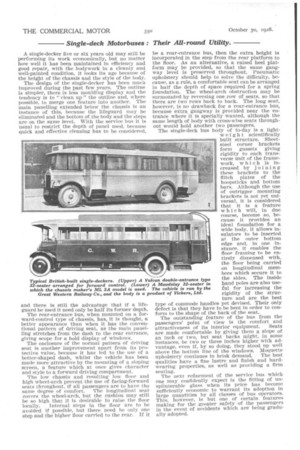Single-deck Motorbuses : Their All-round Utility.
Page 30

If you've noticed an error in this article please click here to report it so we can fix it.
A single-decker five or six years old may still be performing its work economically, but no matter how well it has been maintained in efficiency and good repair, with the bodywork in a cleanly and well-painted condition, it looks its age because of the height of the chassis and the style of the body.
The design of the single-decker has been much improved during the past few years. The outline is simpler, there is less moulding display and the tendency is to "clean up" the outline and, where possible, to merge one feature into another. The main panelling extended below the chassis is an instance of this, because the lifeguard may be eliminated and the bottom of the body and the steps are on the same level. With the service bus it is usual to restrict the depth of panel used, because quick and effective cleaning has to be considered, and there is still the advantage that if a lifeguard be used it need only be half its former depth. The rear-entrance bus, when mounted on a forward-control type of chassis, has, it is thought, a better appearance than when it has the conventional pattern of driving seat, as the main panelling stretches from the dash to the rear entrance, giving scope for a bold display of windows.
The enclosure of the normal pattern of driving seat is another improvement apart from its protective value, because it has led to the use of a better-shaped dash, whilst the vehicle has been made more attractive by the mounting of a sloping screen, a feature which at once gives character and style to a forward driving compartment.
The low chassis and resulting low floor and high wheel-arch prevent the use of facing-forward seats throughout, if all passengers are to have the same degree of comfort. The longitudinal seat covers the wheel-arch, but the cushion may still be so high that it is desirable to raise the floor locally. Internal steps In the floor are to be avoided if possible, but there need be only one step and the higher floor carried to the rear. If it be a rear-entrance bus, then the extra height is incorporated in the step from the rear platform to the floor. As an alternative, a raised heel platform may be provided, so that the same gangway level is preserved throughout. Pneumatic upholstery should help to solve the difficulty, because, as a rule, a comfortable seat can be arranged In half the depth of space required for a spring foundation. The wheel-arch obstruction may be surmounted by reversing one row Of seats, so that there are two rows back to back. The long seat, however, is no drawback for a rear-entrance. bus, because extra gangway is provided near the entrance where it is specially wanted, although the same length of body with cross-wise seats throughout would hold another two passengers.
The single-deck bus body of to-day is a lightweight scientifically built structure. Sheetsteel corner brackets form gussets giving rigidity to each transverse unit of the framework, which is increased by joining these brackets to the flitch plates of the hoopsticks and bottom bars. Although the use of outrigger mounting brackets is not yet universal. it is considered that it is a feature which will, in due course, become so, because it provides an ideal foundation for a wide body, it allows insulators to be inserted at the outer bottom edge and, in one instance, it enables the floor framing to be entirely dispensed with, the floor being carried on longitudinal members which secure it to the sides. The inside band poles are also useful for increasing the rigidity of the structure and are the best type of commode handles yet devised. Their only defect is that they have to be bent in order to conform to the shape of the back of the seat. The outstanding feature of the bus from the passengers' point of view is the comfort and attractiveness of its interior equipment. Seats are made comfortable by giving them a slope of an inch or two, but seat backs might, in some • Instances, be two or three inches higher with advantage, even if, by so doing, they stood up well above the bottom line of the windows. Moquette upholstery continues in brisk demand. The best qualities have a fine lustre and finish and hardwearing properties, as well as providing a firm seating. The next refinement of the service bus which one may confidently expect is the fitting of unsplinterable glass when its price has become sufficiently economic to warrant its adoption in large quantities by all classes of bus operators. This, however, is but one of certain features making for the greater safety of the passengers in the event of accidents which are being gradually adopted.


















































